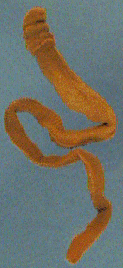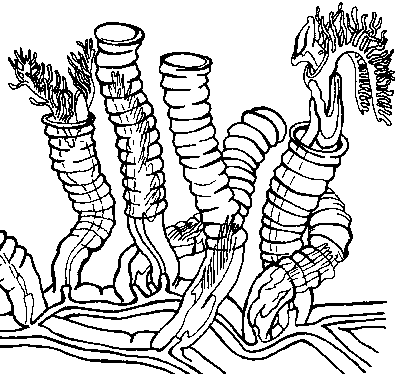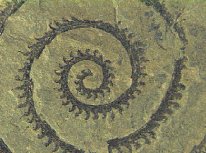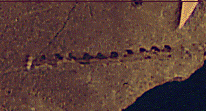
Introduction to the Hemichordata
Of sawblades and acorns. . .

Hemichordates are distinguished by a tripartite (threefold) division of the body. At the forward end of the body is a preoral lobe, behind this is a collar, and last comes a trunk. The name "hemichordate" means "half chordate," and hemichordates share some (but not all) of the typical chordate characteristics. There are branchial openings, or "gill slits," that open into the pharynx; there is a rudimentary structure in the collar region, the stomochord, that is similar to a notochord; and there is a dorsal nerve cord, in addition to a smaller ventral nerve cord. However, hemichordates are not classified as true chordates, although they are quite closely related. Some DNA-based studies of evolution suggest that hemichordates are actually closer to echinoderms than to true chordates. This is supported by the fact that the larvae of at least some hemichordates look very much like those of some echinoderms.
Of the three classes of hemichordates, the most familiar living ones are the Enteropneusta, the acorn worms. One is pictured at the top right of the page. The triple division of the body is obvious. Acorn worms also have multiple branchial openings, as many as 200 in some species. They are slow burrowers, using the proboscis to burrow through sediment, and may either deposit feed (consume sediment and digest the organic matter, rather like earthworms in soil) or suspension feed (collect suspended particles from the water). Some of these worms may be very large; one species may reach a length of 2.5 meters (almost eight feet), although most are much smaller.
The second living class is the Pterobranchia, an obscure group with only about 20 living species. Pterobranchs as very different from acorn worms; they form colonies in which the individuals are interconnected by stems, or stolons. Individuals, or zooids, are often less than 1 millimeter long. The proboscis is not elongated, as it is in acorn worms, but shield-shaped. The second division of the body bears a pair of branched tentacles that collect small food particles from the water. There is only one branchial opening. Most strikingly, almost all pterobranch species create and live within a network of tubes, the coenecium. These tubes are made up of the protein collagen, secreted by special glands in the proboscis. Yet similar larvae and a similar tripartite body plan unite the enteropneusts and pterobranchs. This diagram shows a colony of pterobranchs in the genus Rhabdopleura.



Unlike their pterobranch kin, which typically live encrusting rocks and shells, most graptolites are thought to have been planktonic, floating or slowly sinking through the water. The spiral shape of some was probably an adaptation to slow sinking. Other graptolites may have been connected to gas-filled sacs, keeping them buoyant.


